Research News
- Dr Balaga Mohana Rao receives Best PhD Thesis award from IIT Bombay August 19, 2021
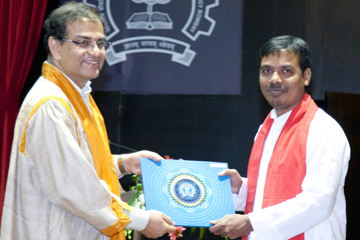 Dr Balaga Mohana Rao, Assistant Professor from the Department of Economics has been awarded the best PhD thesis award in the 59th IIT Bombay convocation held on August 07, 2021. The thesis titled The Early Warnings of the Impending Currency Crises and the Ensuing Macroeconomic Costs aims to develop an Early Warning System to identify the Currency Crises that would help in preventing an impending crisis and also in mitigating the devastating aftermath effects if that occurred.
Dr Balaga Mohana Rao, Assistant Professor from the Department of Economics has been awarded the best PhD thesis award in the 59th IIT Bombay convocation held on August 07, 2021. The thesis titled The Early Warnings of the Impending Currency Crises and the Ensuing Macroeconomic Costs aims to develop an Early Warning System to identify the Currency Crises that would help in preventing an impending crisis and also in mitigating the devastating aftermath effects if that occurred.The financial crises have enthused a huge theoretical and empirical debate in current times due to their recurrent nature in the history of economics. To highlight the importance of an economic crisis among various sections, Kaminsky et al. (1998) quote Kindleberger (1978) saying that academics are interested in a crisis as they have had a history of fascination for the crises, policymakers are interested because they want to prevent the crisis, and financial market participants are interested as they can make money out of it. The financial crises can be divided into two broad categories—currency and sudden stop crises, and debt and banking crises. The currency crises have not only swept away Argentina (2001), Brazil (1998–1999), Latin America (the 1980s), Russia (1998), Southeast Asia (1997) and UK (1992) (to name a few) but they also have caused serious economic adversities to India and BRICS in the recent past. A currency crisis encompasses one of the following four features or a combination of them owing to a speculative attack—both successful and unsuccessful attacks—on a currency: A sharp depreciation of a currency (possibly followed by devaluation) and/or huge depletion of foreign exchange reserves or an increase in interest rates by the central bank or imposing restrictions on capital flows. In this context, Dr Balaga Mohana Rao’s thesis focuses on developing an early warning system to identify the impending crises, finding the common determinants of currency crises and the aftermath effects on macroeconomic indicators.
“One may wonder why the crisis should be prevented or mitigated. The reason is that a full-blown crisis will not be just confined to the foreign exchange market or some other segment, but it will affect the whole economy” Dr Balaga said. He plans to extend his PhD work on Currency Crises and see it in the context of the International Price System.
Continue reading → - Heterojunction photocatalyst for the degradation and mineralization of pharmaceutical effluent: Clozapine August 17, 2021
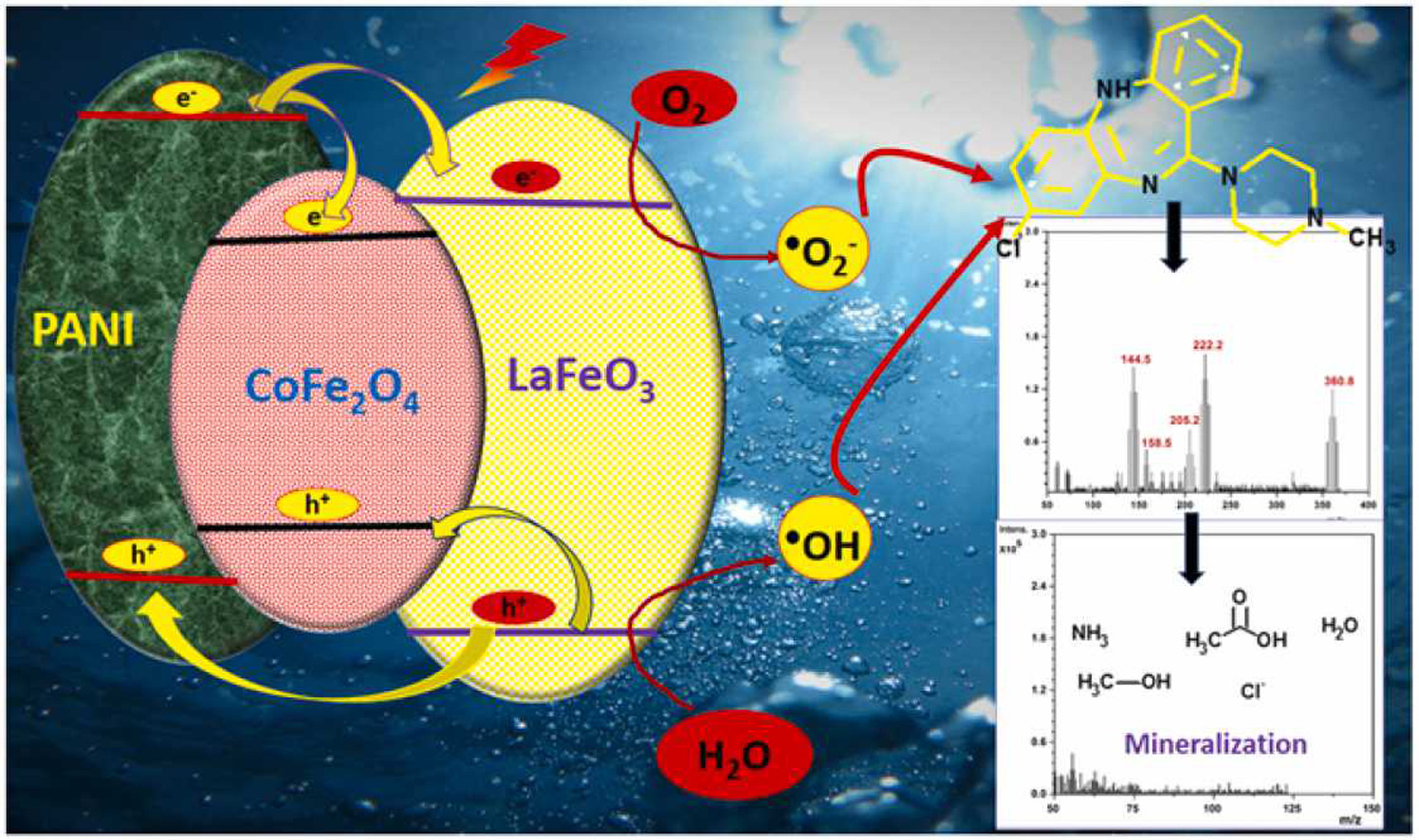 A research paper titled “Robust visible light active PANI/LaFeO3/CoFe2O4 ternary heterojunction for the photo-degradation and mineralization of pharmaceutical effluent: Clozapine” has been published by Dr Lakhveer Singh from the Department of Environmental Science at SRM University – AP, as a co-author, in Journal of Environmental Chemical Engineering, having an Impact Factor of 5.90.
A research paper titled “Robust visible light active PANI/LaFeO3/CoFe2O4 ternary heterojunction for the photo-degradation and mineralization of pharmaceutical effluent: Clozapine” has been published by Dr Lakhveer Singh from the Department of Environmental Science at SRM University – AP, as a co-author, in Journal of Environmental Chemical Engineering, having an Impact Factor of 5.90.Clozapine (CZP) is a second-generation antipsychotic medicine prescribed for the treatment of resistant schizophrenia. The reported side effects of CZP includes cardiometabolic, orthostatic hypotension, tachycardia, seizures, myocarditis, weight gain and obesity. In this research, a novel magnetic ternary PANI/LaFeO3/CoFe2O4 (PLC) heterojunction photocatalyst was developed for the degradation and mineralization of pharmaceutical effluent: Clozapine. The photocatalysts were found to be re-usable for 5 consecutive cycles.
This work has been in collaboration with Central University Jammu. The present study has a new insight into the development and fabrication of efficient ternary heterojunction towards promising application prospects in wastewater remediation.
Dr Lakhveer Singh is an Editorial Board member of the Journal of Biomass Conversion and Biorefinery – Springer (I.F. 2.60) and a Guest Editor for Bioresource Technology Reports- Elsevier.
Read the full paper here: https://doi.org/10.1016/j.jece.2021.106159
Continue reading → - PhD scholars engage in conversation with Pro-Vice-Chancellor August 16, 2021
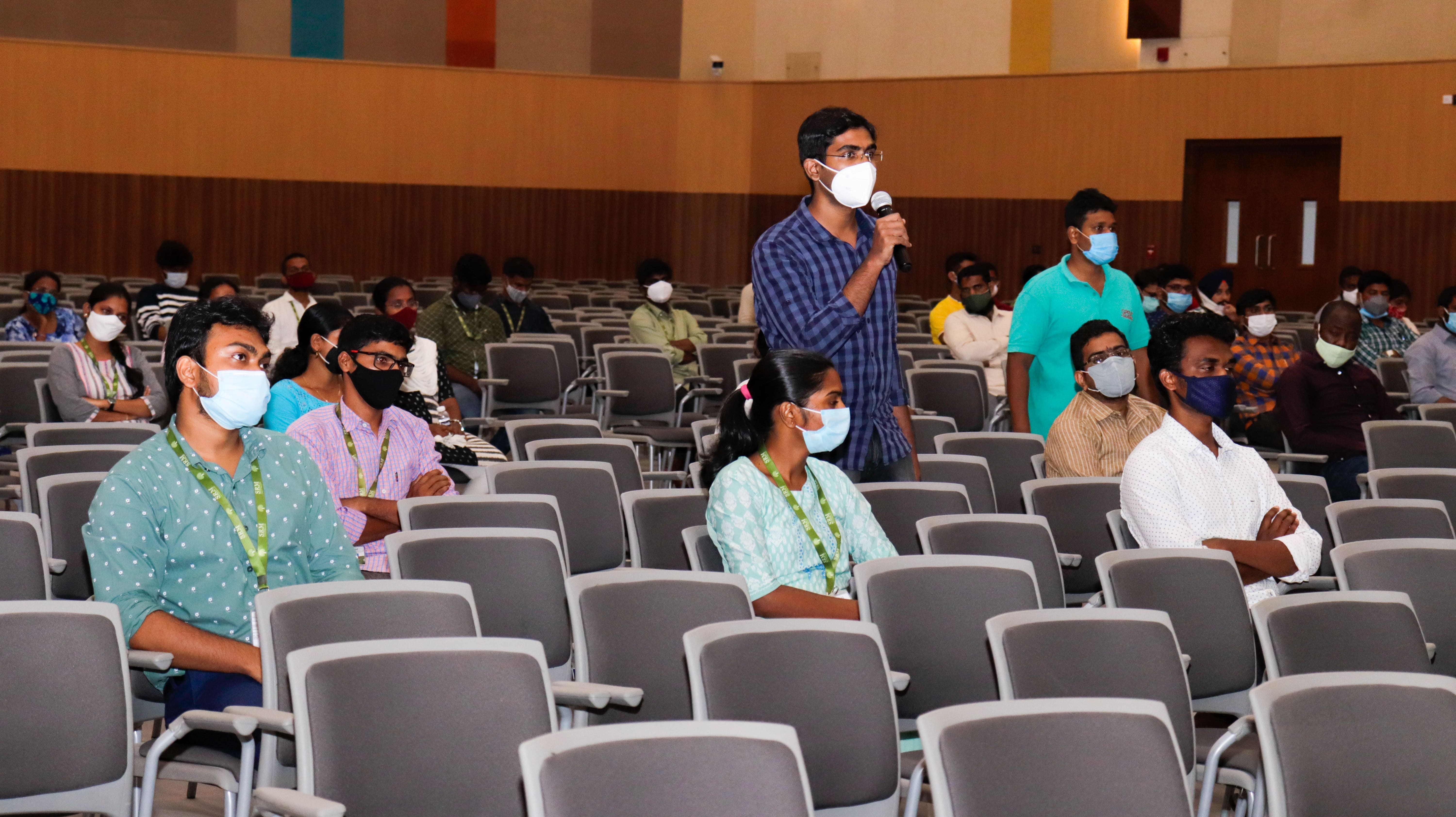 A conversation session between Prof D Narayana Rao, Pro-Vice-Chancellor and the research scholars of SRM University-AP was held on August 10, 2021. On this occasion, Prof Ranjit Thapa’s research scholar from the Department of Physics and Dr Nimai Mishra’s research group from the Department of Chemistry were felicitated for their sustained progress in carrying out research.
A conversation session between Prof D Narayana Rao, Pro-Vice-Chancellor and the research scholars of SRM University-AP was held on August 10, 2021. On this occasion, Prof Ranjit Thapa’s research scholar from the Department of Physics and Dr Nimai Mishra’s research group from the Department of Chemistry were felicitated for their sustained progress in carrying out research.Prof D Narayana Rao elaborated on the state of the art research facilities that SRM University-AP provide to carry out research 24×7. The university has completely centralized laboratories and the scholars can use any lab and equipment depending on the nature of their research. Well furnished lab spaces and working models with fire/safety and security provisions, modernized synthesis equipment and High-end characterization equipment, and fabrication facilities are available for custom made research.
X-ray diffractometer lab; Advanced Materials Laboratory with Radiant Ferroelectric analyser (DST project), custom made furnace for impedance measurements; Applied Nano Materials Lab with Electrochemical reactor, Photochemical reactor, Potentiostat-single channel; Genetics of Aging Laboratory; Colloidal Chemistry Laboratory; Organic Synthesis Lab; are few among the numerous laboratories that SRM University-AP extend to vigorous research projects that are being carried out on our campus.
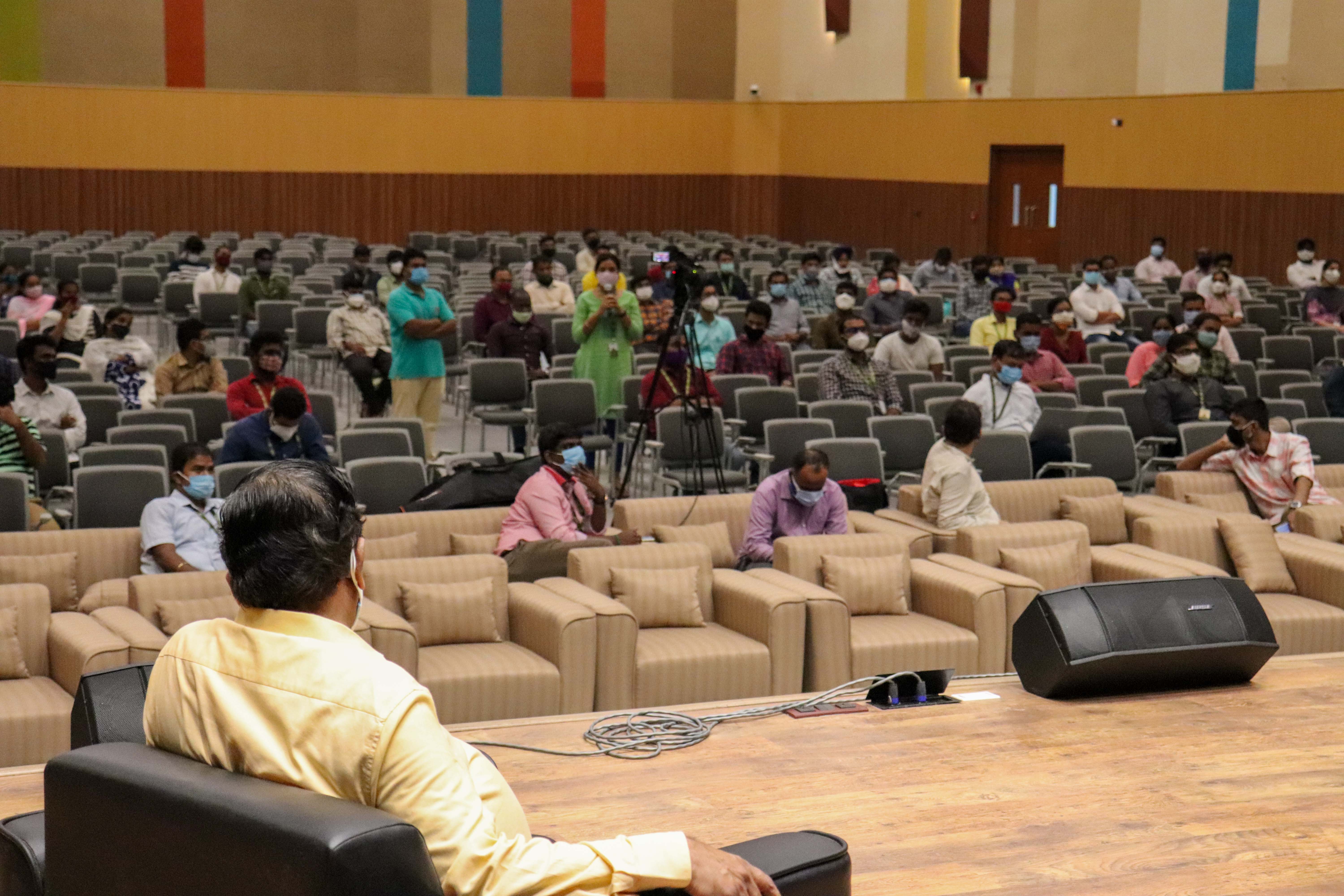
Faculty members and PhD students have published papers in top-ranking journals like Nature, Nature Microbiology, Advanced Energy Materials, Journal of American Society (JACS), Advanced Functional Materials, Advanced Sciences, ACS Nano, IEEE Journals etc The university conducts joint research programmes with NARL, ISRO/DoS and has two industrial projects.
Dr Nimai Mishra expressed that the university has been supportive in moulding young and vibrant researchers. “The scholars of SRM University-AP match up to the level of students from IITs, presenting papers in international conferences and publishing articles in Scopus indexed journals”, he added. Lately, Vasavi Dutt Vankadaru, one of the brilliant minds working on perovskite nanocrystals for light-emitting application, along with Akhil Syed, delivered flash presentation ( e-Poster) at an international conference organised by the Indian Society for Radiation and Photochemical Sciences (ISRAPS).
Continue reading → - Advances of surface-enhanced Raman and IR spectroscopies August 16, 2021
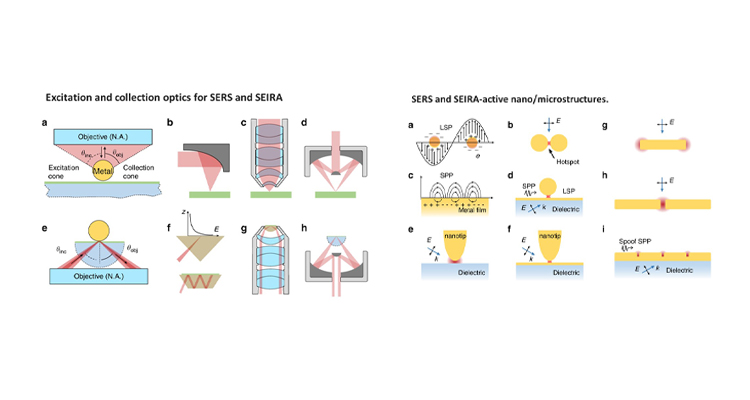 Dr Rajapandiyan Paneerselvam from the Department of Chemistry has published a paper titled “Advances of surface-enhanced Raman and IR spectroscopies: from nano/microstructures to macro-optical design” in the journal Light: Science & Applications, Volume 10, Article number: 161 (2021) having an Impact factor of 17.7.
Dr Rajapandiyan Paneerselvam from the Department of Chemistry has published a paper titled “Advances of surface-enhanced Raman and IR spectroscopies: from nano/microstructures to macro-optical design” in the journal Light: Science & Applications, Volume 10, Article number: 161 (2021) having an Impact factor of 17.7.Raman and infrared (IR) spectroscopy are powerful analytical techniques, which are widely used for a variety of applications including food analysis, environmental analysis, chemical, and biomolecule analysis. This review article presents some latest advancements in vibrational spectroscopic techniques, and further developments in this field are given with emphasis on emerging techniques and methodologies.
This article has been published with Prof Zhong-Qun Tian’s group, State Key Laboratory of Physical Chemistry of Solid Surfaces, Collaborative Innovation Center of Chemistry for Energy Materials, College of Chemistry and Chemical Engineering, Xiamen University, Xiamen, 361005, China.
Furthermore, Dr Rajapandiyan’s research group will focus on the development of plasmonic nanostructures for surface-enhanced Raman spectroscopy and its applications in food science, spectroelectrochemistry, and microfluidics in the future.
Read the full paper here: https://doi.org/10.1038/s41377-021-00599-2
Continue reading → - Vivek Vardhan from ECE files design copyright August 7, 2021
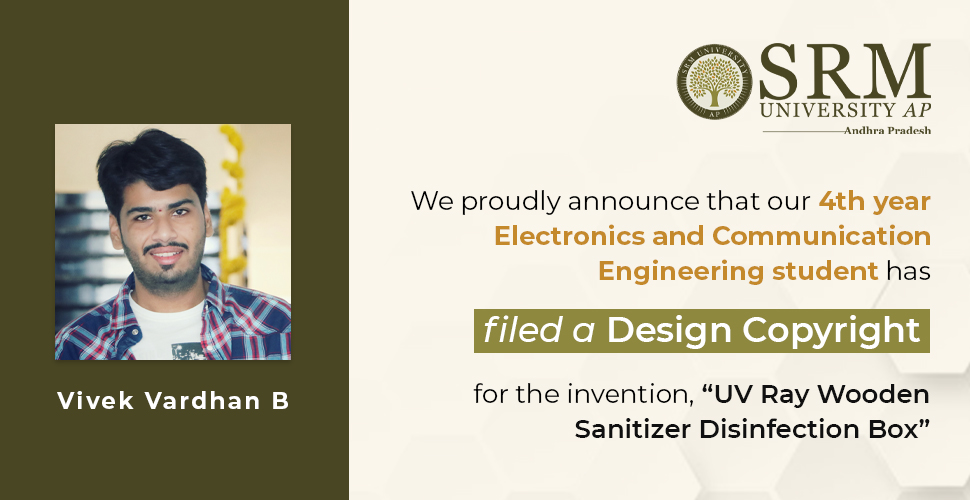 Bitragunta Vivek Vardhan, a final year student from the Department of Electronics and Communication Engineering, has filed a design copyright for developing a “UV Ray Wooden Sanitizer Disinfection Box”. This is a safe chemical-free product designed to disinfect the surfaces of items. In this period of the Covid-19 pandemic, it has been difficult to sanitize mobile phones, tabs, laptops, car/bike keys, wallets, currency/coins, credit/debit cards, newspapers, pens, goggles, spectacles, accessories, milk packets, bakery items, water-absorbing products, delivery packages, toys, clothes etc with liquid sanitisers or else with water.
Bitragunta Vivek Vardhan, a final year student from the Department of Electronics and Communication Engineering, has filed a design copyright for developing a “UV Ray Wooden Sanitizer Disinfection Box”. This is a safe chemical-free product designed to disinfect the surfaces of items. In this period of the Covid-19 pandemic, it has been difficult to sanitize mobile phones, tabs, laptops, car/bike keys, wallets, currency/coins, credit/debit cards, newspapers, pens, goggles, spectacles, accessories, milk packets, bakery items, water-absorbing products, delivery packages, toys, clothes etc with liquid sanitisers or else with water.Researchers say that the coronavirus stays on surfaces of plastic (3-7 days), stainless steel (3-7 days), copper (up to 4 hours), paper (up to 4 days), glass (4 days), cardboard (24 hours), and wood (up to 2 days). UVC has a wavelength of 10 nm to 400 nm and is used for the disinfection method that has short-wavelength light to kill or inactivate microorganisms by destroying nucleic acids and disrupting their DNA, leaving them unable to perform vital cellular functions. The UVC light used in the product will not penetrate into solid surfaces and it is safe to use on touchscreen mobiles, laptops, tabs, etc. It is also proven that the disinfection box can destroy the bacteria and viruses on the surface of food items without causing any harm to the edibility.
“In future, I have plans to take this project to the next level by designing large dimensions of the box and making it work automatically with remote control through our mobile phone. I am extremely happy about filing the copyright and I express my heartfelt gratitude to Prof Siva Sankar Sir and Pro VC Prof D Narayana Rao Sir for giving me the opportunity and supporting me to expand my idea up to the level of implementation. And I thank Prof Vinod Kumar Sir for taking care of the filing process. Finally, I thank SRM University-AP for encouraging and nurturing young talents in all ways possible, “ Vivek stated.
Continue reading → - Dr Nimai Mishra’s research group studies new surface capping ligands August 2, 2021
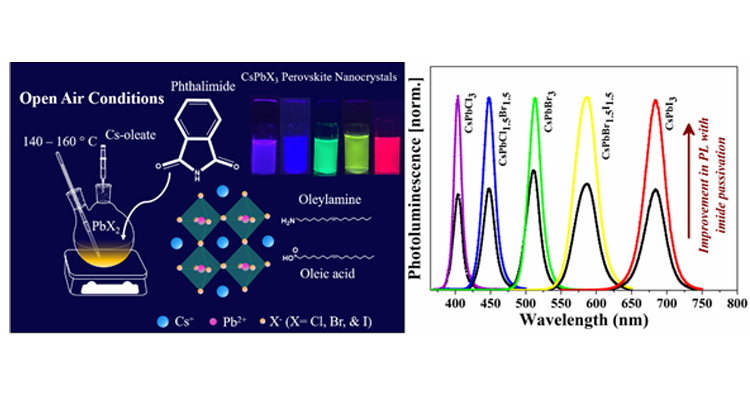 Dr Nimai Mishra, Assistant Professor, Department of Chemistry, SRM University-AP, Andhra Pradesh, along with his research group pursuing PhD under him-Ms V.G.Vasavi Dutt and Mr Syed Akhil- have published a research article titled “Enhancement of Photoluminescence and Stability of CsPbX3 (X= Cl, Br, and I) Perovskite Nanocrystals with Phthalimide Passivation” in the Journal “Nanoscale” (The Royal Society of Chemistry, Impact Factor-7.8).
Dr Nimai Mishra, Assistant Professor, Department of Chemistry, SRM University-AP, Andhra Pradesh, along with his research group pursuing PhD under him-Ms V.G.Vasavi Dutt and Mr Syed Akhil- have published a research article titled “Enhancement of Photoluminescence and Stability of CsPbX3 (X= Cl, Br, and I) Perovskite Nanocrystals with Phthalimide Passivation” in the Journal “Nanoscale” (The Royal Society of Chemistry, Impact Factor-7.8).Caesium lead halide perovskite nanocrystals (CsPbX3 NCs) have been the flourishing area of research in the field of photovoltaic and optoelectronic applications because of their excellent optical and electronic properties. However, they suffer from low stability and deterioration of photoluminescence (PL) properties post-synthesis. One of the ways to minimize the surface defects in the surface treatment with suitable ligands is to achieve the NCs with superior PL properties for light-emitting applications.
In this article, Dr Mishra’s research group demonstrates that incorporating an additional ligand can further enhance the optical properties and stability of NCs. Here, we introduced phthalimide as a new surface passivation ligand into the oleic acid/oleylamine system in situ to get near-unity photoluminescence quantum yield (PLQY) of CsPbBr3 and CsPbI3 perovskite NCs. We observed, phthalimide passivation dramatically improves the stability of CsPbCl3, CsPbBr3, and CsPbI3 NCs under ambient light and UV light. The PL intensity is recorded for one year which showed a dramatic improvement for CsPbBr3 NCs. Nearly 11% of PL can be retained even after one year for phthalimide passivated samples, on the other hand, the PL of as-synthesized NCs completely diminishes in four months. CsPbCl3 NCs exhibit 3 times higher PL with phthalimide and retain 12% PL intensity even after two months while PL of as-synthesized NCs completely diminishes by then. Under continuous UV light illumination, the PL intensity of phthalimide passivated NCs is well preserved while the as-synthesized NCs exhibit negligible PL emission in 2 days. About 40% and 25% of initial PL is preserved for CsPbBr3 and CsPbCl3 NCs in the presence of phthalimide. CsPbI3 NCs with phthalimide exhibit PL even after 2 days while the PL is rapidly declined for as-synthesized NCs in the first 10 hours. The presence of phthalimide in CsPbI3 NCs could maintain stability even after a week while the as-synthesized NCs under transition to non-luminescent phase within 4 days.
Furthermore, blue, green, yellow, and red-emitting diodes by using CsPbCl1.5Br1.5, CsPbBr3, CsPbBr1.5I1.5, CsPbI3 NCs respectively are fabricated by drop-casting NCs onto blue LED lights which show the great potential of the use of these phthalimide passivated NCs in the field of display and light technologies.
Read the full paper here: https://pubs.rsc.org/en/content/articlelanding/2021/nr/d1nr03916d
Continue reading → - Assessing the benefits of irrigation against heat stress in agriculture July 24, 2021
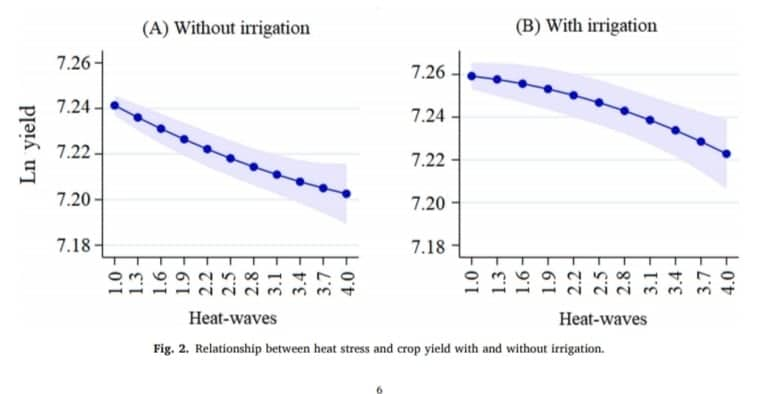 Heat stress negatively affects crop yield and its impact has increased over time. Researchers in India study this situation with utmost priority. Consequently, Dr Ghanshyam Kumar Pandey, Assistant Professor in the Department of Economics at SRM University-AP has co-authored a paper with Pratap S Birthal and et. al titled “Benefits of irrigation against heat stress in agriculture: Evidence from wheat crop in India” in the journal Agricultural Water Management, Vol 255, having an Impact factor 4.02.
Heat stress negatively affects crop yield and its impact has increased over time. Researchers in India study this situation with utmost priority. Consequently, Dr Ghanshyam Kumar Pandey, Assistant Professor in the Department of Economics at SRM University-AP has co-authored a paper with Pratap S Birthal and et. al titled “Benefits of irrigation against heat stress in agriculture: Evidence from wheat crop in India” in the journal Agricultural Water Management, Vol 255, having an Impact factor 4.02.Applying the fixed effects regression technique to the highly spatially disaggregated district-level data from 1966–67 to 2011–12. This paper has assessed the impact of heat stress on wheat production in India and concurrently evaluated the role of irrigation in offsetting its harmful impact. The study has brought out three key highlights:
(i) Heat stress negatively impacts crop yield, and the impact has increased over time.
(ii) Irrigation, besides its contribution towards improving crop yield, also moderates the harmful impact of heat stress, but over time its effectiveness has declined.
(iii) The measure of heat stress built on multiple aspects of excess temperature (i.e., intensity, persistence, and frequency) explains variation in crop yield better than working on a single aspect of it.Given the increasing scarcity of irrigation water and rising temperature, these findings suggest the need for exploring technological and policy options for improving irrigation water use, efficiency, and breeding of crops for heat tolerance and low water footprints.
This research paper is written in collaboration with ICAR-National Institute of Agricultural Economics and Policy Research, PUSA, New Delhi. Dr Ghanshyam’s future projects are focused on climate change and agriculture, and the effect of climate change on the livestock sector in India.
Read the full paper here: https://doi.org/10.1016/j.agwat.2021.106950
Continue reading → - Controlled loading of MoS2 on hierarchical porous TiO2 for enhanced photocatalytic hydrogen evolution July 19, 2021
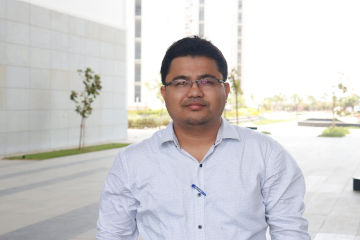 Ever since the breakthrough research on H2 photogeneration from water using TiO2 under UV-light irradiation, an enormous amount of research has been conducted on photochemical H2 evolution using different semiconductor-based photocatalysts. Consequently, a research paper titled “Controlled Loading of MoS2 on Hierarchical Porous TiO2 for Enhanced Photocatalytic Hydrogen Evolution” has been published by Prof Ranjit Thapa, Professor of Physics, SRM University – AP, as a co-author, in The Journal of Physical Chemistry C, having an Impact Factor of 4.189.
Ever since the breakthrough research on H2 photogeneration from water using TiO2 under UV-light irradiation, an enormous amount of research has been conducted on photochemical H2 evolution using different semiconductor-based photocatalysts. Consequently, a research paper titled “Controlled Loading of MoS2 on Hierarchical Porous TiO2 for Enhanced Photocatalytic Hydrogen Evolution” has been published by Prof Ranjit Thapa, Professor of Physics, SRM University – AP, as a co-author, in The Journal of Physical Chemistry C, having an Impact Factor of 4.189.In this work, Prof Thapa describes three important factors for helping in the generation of hydrogen using proposed MoS2/TiO2 catalyst, (i) TiO2 for effective charge transfer, (ii) MoS2 for plasmon induction (iii) large surface area and active sites. It was shown that hierarchical porous TiO2 can be interfaced successfully with marigold-flower-like MoS2 flakes with intriguing photophysical properties, viz., visible-light response, controlled electron−hole recombination, and sustainable H2 production over prolonged light irradiation due to the synergic effect of flowerlike MoS2 and the fibrous wormhole mesoporous channel of TiO2. Further, the researchers have used density functional theory (DFT) to identify the active sites and calculated the change in Gibbs free energy (ΔGH). “We have also studied the charge density difference to understand about electron transfer pathway. The change free energy of hydrogen adsorption (ΔGH*) is a good indicator to estimate the hydrogen evolution activity in the acidic medium. From the DFT study, it is clear that O sites of MPT heterostructure are more favourable for HER reactivity”, said Prof Ranjit Thappa.
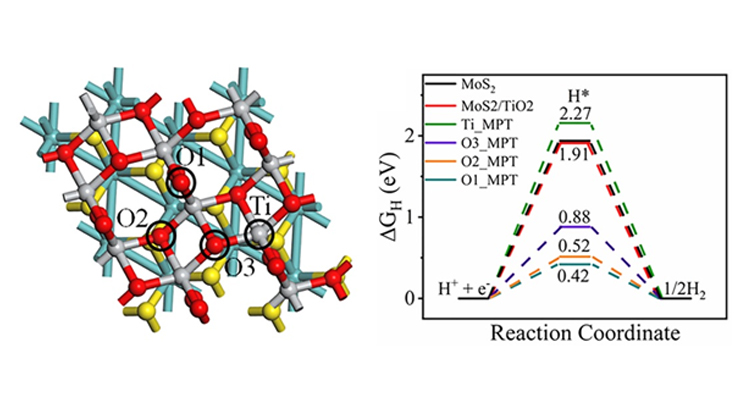
Social implications of the research:
In the last few decades, with the decline in non-renewable resources and increasing environmental pollution, significant attention has been given to renewable and clean energy domains. Hydrogen is considered one of the most suitable energy carriers due to its higher energy density per unit mass in comparison to other chemical fuels. In recent times, photocatalytic fission (Photocatalysis is a process in which light energy is used to drive pairs of chemical reactions. Through the absorption of light, an excited electron/hole pair is produced) of water has been considered an attractive solution for solar to chemical H2 energy conversion. Also, the process of water splitting is highly endothermic. Therefore, the development of an excellent, stable, efficient, and economical photocatalyst for ultrahigh H2 production efficiency is paramount to researchers.This work is done in collaboration with the Department of Energy and Environmental Engineering, CSIR-Indian Institute of Chemical Technology, Hyderabad 500007, India.
Prof Ranjit Thapa is doing an investigation to find the possibility of hydrogen evolution reaction (HER) on multiple borophene analogues (α, β12, χ3) on all unique sites. Understanding the role of the coordination number of the boron atoms in the borophene analogues with the HER efficiency, and studying the pathways Volmer-Tafel (V-T) on each site to understand the completed HER process on borophene analogues are his future research projects. His research group is also interested to identify the role of sigma and pi-electron occupancy on the V-T pathway.
Read the full paper here: https://doi.org/10.1021/acs.jpcc.1c01922
Continue reading → - Dr Nimai Mishra’s research group develops a new synthetic strategy to make ultra-stable CsPbBr3 perovskite nanocrystals for light-emitting application July 14, 2021
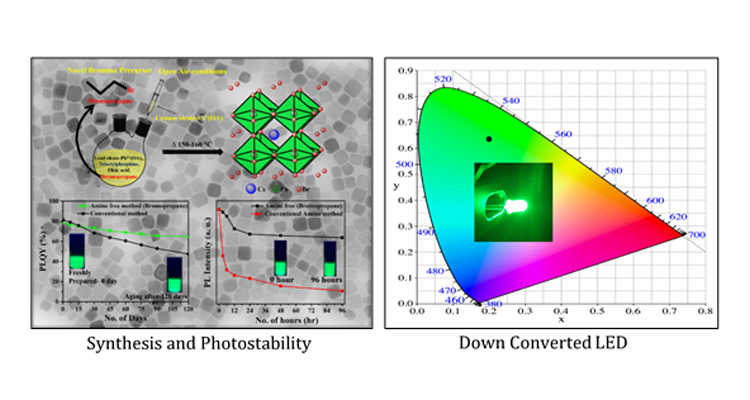 Dr Nimai Mishra, Assistant Professor in the Department of Chemistry, SRM University-AP, Andhra Pradesh, along with his research group comprising of students pursuing PhD under his supervision, Mr Syed Akhil and Ms V.G.Vasavi Dutt have published a research article titled “Bromopropane as a Novel Bromine Precursor for the Completely Amine Free Colloidal Synthesis of Ultra-Stable and Highly Luminescent Green-Emitting Cesium Lead Bromide (CsPbBr3) Perovskite Nanocrystals” in the Journal “Nanoscale” (The Royal Society of Chemistry, Impact Factor-7.8).
Dr Nimai Mishra, Assistant Professor in the Department of Chemistry, SRM University-AP, Andhra Pradesh, along with his research group comprising of students pursuing PhD under his supervision, Mr Syed Akhil and Ms V.G.Vasavi Dutt have published a research article titled “Bromopropane as a Novel Bromine Precursor for the Completely Amine Free Colloidal Synthesis of Ultra-Stable and Highly Luminescent Green-Emitting Cesium Lead Bromide (CsPbBr3) Perovskite Nanocrystals” in the Journal “Nanoscale” (The Royal Society of Chemistry, Impact Factor-7.8).Recently, lead halide perovskite nanocrystals (PNCs) have attracted intense interest as promising active materials for optoelectronic devices. However, their extensive applications are still hampered by poor stability in ambient conditions. In this work, Dr Mishra’s research group report an open-atmospheric, facile, efficient, completely amine-free synthesis of caesium lead bromide perovskite nanocrystals using a novel bromine precursor, bromopropane, which is inexpensive, and available at hand. Their finding concludes that the PLQY can maintain 83% of their initial one even after 120 days. Furthermore, after 96 h of continuous irradiation by UV light with 365 nm (8 W/cm2) in the open ambient condition the photoluminescence (PL) intensity showed retention of 68% of its original value with no significant change in full width at half-maximum, whereas amine-based sample retains only 5% of its original PL intensity. Furthermore, Dr Mishra’s group has fabricated stable down-converted LED devices with these perovskite nanocrystals.
“More importantly, the present work demonstrates the synthesis of ultra-stable CsPbBr3 NCs which can be an ideal candidate for display applications”, says Dr Nimai Mishra.
Read the full paper: https://pubs.rsc.org/en/Content/ArticleLanding/2021/NR/D1NR03560F#!divAbstract
Continue reading →
- Application-driven industrial-scale manufacturing of Li/Na-ion battery cathodes July 13, 2021
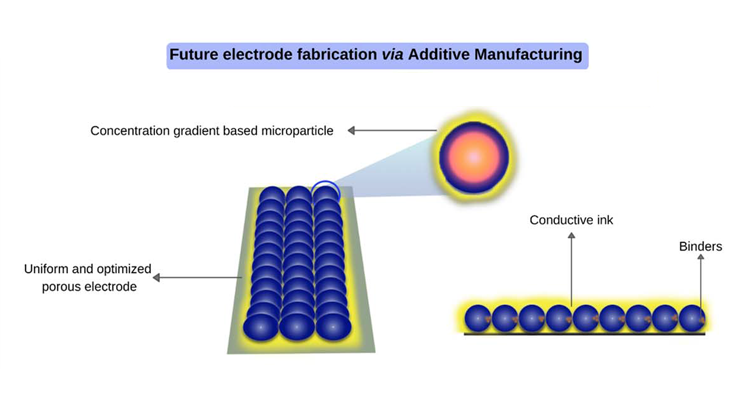 The advent of the industrial revolution increased the dependency of humans on fossil fuels which led to an increase in environmental degradation. While alternative energy sources such as wind, solar and hydro seem to be good options, their uncertainty in delivering the power made Dr Sujith Kalluri, Assistant Professor in the Electronics and Communication Engineering Department and his PhD scholar Chanakya Karra at SRM University-AP prefer batteries as a viable option. “Application-driven Industrial-scale Manufacturing of Li/Na-ion Battery Cathodes” is a paper published by Dr Sujith Kalluri and Mr Chanakya Karra in the Journal of The Electrochemical Society having an Impact Factor of 3.721 as part of their project to develop zero-emission energy methods.
The advent of the industrial revolution increased the dependency of humans on fossil fuels which led to an increase in environmental degradation. While alternative energy sources such as wind, solar and hydro seem to be good options, their uncertainty in delivering the power made Dr Sujith Kalluri, Assistant Professor in the Electronics and Communication Engineering Department and his PhD scholar Chanakya Karra at SRM University-AP prefer batteries as a viable option. “Application-driven Industrial-scale Manufacturing of Li/Na-ion Battery Cathodes” is a paper published by Dr Sujith Kalluri and Mr Chanakya Karra in the Journal of The Electrochemical Society having an Impact Factor of 3.721 as part of their project to develop zero-emission energy methods.Through this article as a platform, the authors focus on three aspects of energy storage devices that are essential while the world is catapulted to upgrade itself from fossil fuels to electric vehicles. From a battery level perspective, they have discussed the dependence of the battery industry on lithium-ion technology and its repercussions. As a solution, they suggest the distribution of the dependency on sodium-ion technology owing to its adaptability and wide availability. From the cathode level perspective, the paper suggests co-precipitation through the CSTR as a customized solution to address the setbacks in the synthesis process and additive manufacturing as a preferred solution to cater for the desired electrode design specifications that would comply with the needs of future generations and the industry. Till the battery energy storage system paves the way for Na to take over, we can reckon on SC-NCM cathode material to serve the needs.
Read the full paper here: https://iopscience.iop.org/article/10.1149/1945-7111/abfab6/pdf
More about the Battery research project of SRM University-AP:https://arc2025.srmap.edu.in/seas/electronics-and-communication-engineering/research-areas/battery-research/
Continue reading →

